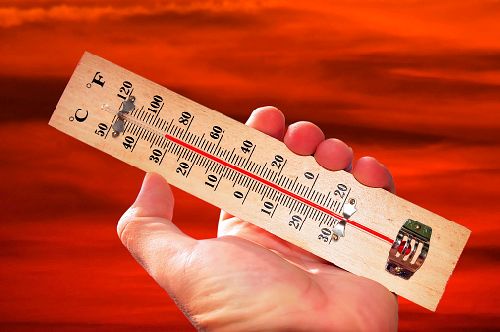UPDATE JULY 24, 2023: With much of the country continuing to experience record heat right now, I wanted to highlight the following article that we originally published several years ago on the dangers of extreme heat and humidity. The information in this article, which is still accurate, doesn’t just apply to areas accustomed to extreme heat, like the South and Southwest. It also applies to northern areas that are now more frequently experiencing extreme heat. — Robin Hattersley, CS Editor-in-Chief
Over a 30-year period from 1986 through 2015, the National Weather Service reports that, on average, far more people die each year from extreme heat than any other weather-related hazard. Around 113 to 130 people succumb to heat each year, compared to 82 to flooding, 70 to tornadoes, and 46 to hurricanes.
As the summer of 2016 comes to a close, the threat of extreme heat may be starting to wane, but it was anything but a quiet summer for weather…even in the far reaches of the country. Deadhorse on Alaska’s North Slope shattered an all-time high temperature of 84 degrees on July 13. While that may sound delightful to many, if you’re not accustomed to that sort of thing, it could be downright deadly.
Simply put, large parts of the country are not accustomed or well equipped for high heat and humidity. Central air conditioning may be a staple for the Southeast, but many communities farther north lack such luxuries. So, when the heat comes calling, especially if it’s a sticky, muggy, humid heat, even open windows and box fans won’t do the trick. Many heat-related fatalities occur in northern cities like Chicago, Detroit, Minneapolis and Milwaukee. Unfortunately, the elderly tend to be the most susceptible in these areas.
Before we dismiss heat as a threat that only affects the elderly, we must recognize that many more fatalities occur to those working or playing outdoors. According to the Occupational Safety and Health Administration (OSHA), 2,630 workers suffered from heat illness and 18 people died from heat stroke and related causes on the job. OSHA further acknowledges that workers who have not built up a tolerance to heat conditions, including new workers, temporary workers or those returning from more than a week or more off are at greater risk. For those who live in parts of the country that are not accustomed to the extreme heat, the risk is higher because of lack of tolerance.
Heat Index Is Only Half the Story
The common go-to number we all reference to assess our risk for heat issues is heat index. Heat index is the measure that accounts for temperature and humidity combined. Many weather providers will refer to this as the “feels like” temperature. For example, a high temperature of 94 degrees combined with 75 percent relative humidity will have a heat index of 103. This is often translated into saying that “it will feel like 103 degrees outside.” The National Weather Service places that number in the “danger” zone for heat disorders.
Unfortunately, what most people don’t know is that heat index paints a deceptive picture. The fact is that it measures what it will feel like for someone sitting still in the shade. It is not a true reflection of what the heat is doing to the body for those out in full sun, actively engaged in exercise or work. For those who are fully exposed to the sun’s wrath, the danger is magnified significantly.
Heat index is just a surface factor of a potentially dangerous situation on your hands. Consider that athletes, outdoor employees, fitness enthusiasts, summer campers and others don’t always have the luxury of shade. They most certainly are not sitting still either. The U.S. military was one of the first organizations to realize that they needed to do more to keep personnel safe while actively engaged in their training and duties.
Wet Bulb Globe Temperature: Big Name, Big Deal
The term “Wet Bulb Globe Temperature” is certainly a mouthful. WBGT for short, it is quickly becoming the most widely used index of heat stress. WBGT was invented and first used during the 1950s as one element in a successful campaign to control serious outbreaks of heat illness in U.S. Army and Marine Corps training camps. It is a measurement of apparent temperature used to estimate the effect of temperature, humidity, wind speed, and visible and infrared radiation from sunlight on the exposed human body. In other words, what it feels like on the human body actively engaged in work in direct sunlight.
WBGT is not an entirely new concept on campus. The American College of Sports Medicine has been publishing guidelines for the use of WBGT in athletics for a long time. Many industrial hygienists in outdoor professions also use the measure for the protection of employees, yet so many Americans have never heard of WBGT. What’s that all about? The answer is that until recently, the calculation of WBGT required highly localized measurements using hand-held sensors.
Given the challenging need to conduct localized measurements in real-time, the use of WBGT previously had been limited to the most disciplined of entities like the military and dedicated sports trainers. Without the convenience of automated readings, the measurement of WBGT has to be a concerted and conscious effort. Without the right equipment, there’s not much one can do to calculate WBGT.
There are several limitations to WBGT. First, it is a highly localized measurement of numerous variables. A reading where you stand now can be entirely different a few hundred yards away because of different wind flow around buildings and so forth. Furthermore, things are constantly changing – full blazing sun this minute may give way to a passing cloud the next. This can change the readings quite a bit. Therefore, it’s important to interpret WBGT as an approximation rather than a precise science. In other words, don’t split hairs between one number and the next. If it’s dangerously hot, take action.







